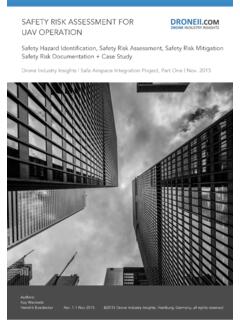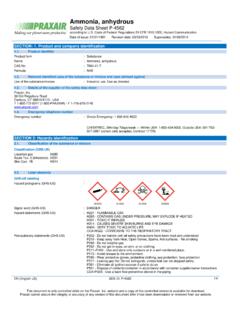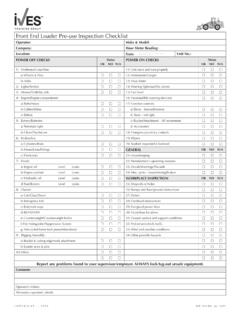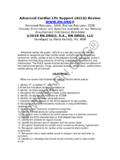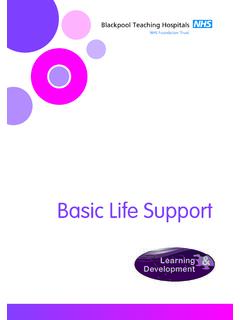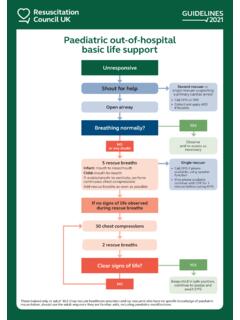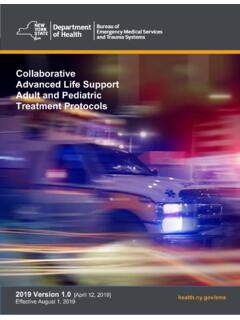Transcription of American Heart Association Basic Life Support for ...
1 American Heart AssociationBasic life Support forHealthcare ProvidersPretestANNOTATED ANSWER KEYF ebruary 2001 This examination to be used only as aPRECOURSE TESTfor BLS for Healthcare Providers Courses 2001 American Heart AssociationBLS for Healthcare Providers Course Pretest 2 Annotated Answer KeyBLS for Healthcare Providers CourseWritten Examination at work in a hospital you find an adult victim who has collapsed. No one is available tohelp. After you ensure that the scene is safe, what should you do next?a. Check for unresponsiveness; if the victim is unresponsive, activate the emergencyresponse system (or phone 911) and get the AED if availableb. Phone 911 (or activate the emergency response system), then wait outside to direct theemergency respondersc.
2 Open the airway with a tongue-jaw lift and perform 2 finger sweeps to check if food is blockingthe airwayd. Perform CPR for 1 minute, then phone 911 The correct answer is first action should be to determine if the person is unresponsive; if the victim is an unreponsiveadult you should activate the hospital emergency response system. If emergency equipment(including an AED) is available, you should get it at the same time you activate the emergencyresponse b is incorrect because after you activate the emergency response system you should returnto the collapsed victim and perform CPR until the emergency response team c is incorrect because finger sweeps are indicated for relief of foreign-body airwayobstruction (FBAO). You have no indication that the collapsed victim has an d is incorrect because you should not perform CPR without first assessing the victim, andyou should not delay activating the emergency response system for an unresponsive adult more about it:BLS for Healthcare Providers, Chapter 1: Chain of Survival, pages 5-8, and Chapter 6: TheSequence of BLS, pages 65-81 Fundamentals of BLS for Healthcare Providers, Chapter 1: Chain of Survival, pages 3-6, andChapter 2: Steps of CPR, pages 18-25 BLS for Healthcare Providers Course Pretest work with an overweight 55-year-old dentist with no known history of Heart disease.
3 Hebegins to complain of sudden, severe, "crushing" pain under his breastbone, in the center ofhis chest. The pain has lasted more than 5 minutes. What problem should you think of rightaway, and what should you do?a. Heartburn; tell him to take an antacidb. Angina; phone his personal physicianc. Heart attack; phone 911d. Arrhythmia; drive him to an Emergency DepartmentThe correct answer is man has no known Heart disease, so you should phone 911 (or the emergency responsesystem) immediately. If he had a history of Heart disease and was taking nitroglycerin, you couldsuggest that he take up to 3 nitroglycerin tablets to see if they had any effect on the a is incorrect because symptoms of a Heart attack are often dismissed as heartburn. Youshould not delay phoning 911 or other emergency response number. The risk of arrhythmias anddeath is highest in patients with myocardial infarction ( Heart attack) during the first hour after theonset of symptoms this is the time when the victim is most in need of EMS b is incorrect because a call to a personal physician will take unnecessary time and delaytransportation to an Emergency Department.
4 EMS personnel are prepared to treat suddenarrhythmias that may develop during transport, and they can provide prearrival notification to thereceiving hospital to speed care at the hospital after the victim d is incorrect for 2 reasons. First, the victim is demonstrating "red flag" warning signs of aheart attack. Second, the safest and fastest transport to an Emergency Department is provided byEMS personnel. If you were to drive the victim, you would not be able to provide (1) emergency careto the victim while you were driving, (2) prearrival notification to the receiving hospital, or (3) triage ofthe victim to identify the medical facility most appropriate for his more about it:BLS for Healthcare Providers, Chapter 3: ACS and Myocardial Infarction, pages 25-30, particularlyCritical Role of Early EMS Activation, page 27 Fundamentals of BLS for Healthcare Providers, Chapter 1: Warning Signs, pages witnessed the collapse of a 45-year-old man.
5 You are now performing CPR after sendingsomeone to phone 911. You have done your best to ensure that the first 2 links in the Chainof Survival have been completed immediately. What is the third link in the chain, which willhave the greatest effect on increasing this man's chance of survival?a. Arrival of paramedics who will administer drugsb. Transportation of the man to a hospitalc. Arrival of a rescuer with a defibrillatord. Arrival of EMS personnel who can do CPRThe correct answer is combination of immediate CPR and prompt defibrillation provides the best possibility of survivalfrom sudden cardiac arrest. CPR will keep oxygen-rich blood flowing to the Heart and brain until thedefibrillator is used to convert the cardiac rhythm to a perfusing rhythm. Although time todefibrillation is the single most important determinant of survival from sudden cardiac arrest, bothCPR and defibrillation are important links to maximize the victim's chance of for Healthcare Providers Course Pretest 4 Answer a is incorrect because pharmacologic therapy has not been shown to improve survival fromsudden cardiac arrest.
6 Advanced life Support is not the third link in the Chain of Survival, and it doesnot have the greatest effect on survival from sudden cardiac b is incorrect because although EMS transport is important, it is not the third link in theChain of Survival. Early defibrillation has the greatest effect on the victim's d is incorrect because you have already started CPR. The highest rate of survival fromsudden cardiac arrest is associated with bystander CPR (the second link in the Chain of Survival) incombination with defibrillation (the third link).Read more about it:BLS for Healthcare Providers, Chapter 1: AHA Adult Chain of Survival, pages 5-8, and Chapter 7:Principle of Early Defibrillation, pages 92-93 Fundamentals of BLS for Healthcare Providers, Chapter 1: AHA Adult Chain of Survival, pages 3-7,Chapter 3: Link Between Early Defibrillation and Survival From cardiac Arrest, page have been talking with a 60-year-old man.
7 He is alert and has been conversing at once he complains of a sudden weakness on one side of his face and in one arm. He isalso having trouble speaking. What is the most likely cause of his problem?a. A seizureb. A Heart attackc. A stroked. Diabetic comaThe correct answer is scenario describes several of the classic signs of an acute stroke (sudden numbness orweakness on one side of the body, facial droop or weakness, and difficulty speaking). Recognition ofthe early signs and symptoms of stroke is important. If this patient has suffered an acute ischemicstroke and receives immediate medical attention, he may be eligible for fibrinolytic therapy("clotbusters"), which can reduce disability from stroke. But the drugs must be administered within 3hours of the onset of stroke a is incorrect because no signs or symptoms of a seizure are mentioned in this scenario the man has been alert and conversing normally with b is incorrect because a Heart attack does not produce weakness in the arm and face withspeech abnormalities.
8 The major symptom of a Heart attack is severe chest pain, pressure, d is incorrect because a diabetic coma produces decreased responsiveness orunresponsiveness. Hypoglycemia, however, can cause confusion and focal neurologic more about it:BLS for Healthcare Providers, Chapter 4: Prehospital Management of Stroke, pages 40-43 Fundamentals of BLS for Healthcare Providers, Chapter 1: Warning Signs, pages 10-12 BLS for Healthcare Providers Course Pretest remove a 3-year-old from the bottom of the shallow end of a swimming pool. You findthat she is limp and unresponsive. No other person is available to help. When should youphone 911?a. After you have given the child 1 minute of CPRb. As soon as you remove the child from the poolc.
9 When you see that after several minutes of CPR there is no responsed. After giving a few ventilations and before beginning chest compressionsThe correct answer is arrest in children and near-drowning victims of all ages is most commonlyassociated with lack of oxygen. The lone rescuer must begin the steps of CPR to deliver oxygen tothe child immediately, then phone 911 after about 1 minute of CPR. Of course if someone else isavailable to help, that person can phone 911 b is incorrect because phoning 911 will delay getting oxygen to the little girl. She needsimmediate CPR. If she is not breathing when you open her airway, you should begin rescuebreathing as soon as possible, even in the c is incorrect because doing several minutes of CPR will delay getting emergency help. Ifthe child fails to respond to about 1 minute of CPR, advanced life Support is needed d is incorrect because you should phone 911 after about 1 minute of rescue more about it:BLS for Healthcare Providers, Chapter 9: Epidemiology of Cardiopulmonary Arrest,pages 135-136, and Activate EMS System, pages 145-146 Fundamentals of BLS for Healthcare Providers, Chapter 4: Pediatric Chain of Survival, pages 58-60,and Chapter 5: The ABCs of CPR, pages are a medical advisor helping set up a public access defibrillation (PAD) program at alocal shopping mall.
10 The mall has purchased an AED. The mall personnel director asks, "IfAEDs are so 'foolproof,' why do the security guards have to learn CPR and be trained to usethe AED?" Which of the following is the best explanation for the need to train rescuers toperform CPR and use an AED?a. Rescuers don't need to learn CPR if they can use an AEDb. Rescuers need to be able to verify the rhythm analyzed by the AEDc. Rescuers need to know when and how to use the AED safely and to perform the steps ofCPR for unresponsive victims who are not in cardiac arrestd. Rescuers will need to learn to maintain the AED and repair it if something goes wrongThe correct answer is best survival from sudden cardiac arrest will result from provision of immediate bystander CPRand defibrillation within minutes. To do this the rescuer must know the signs of cardiac arrest thatindicate the need to use the AED.


